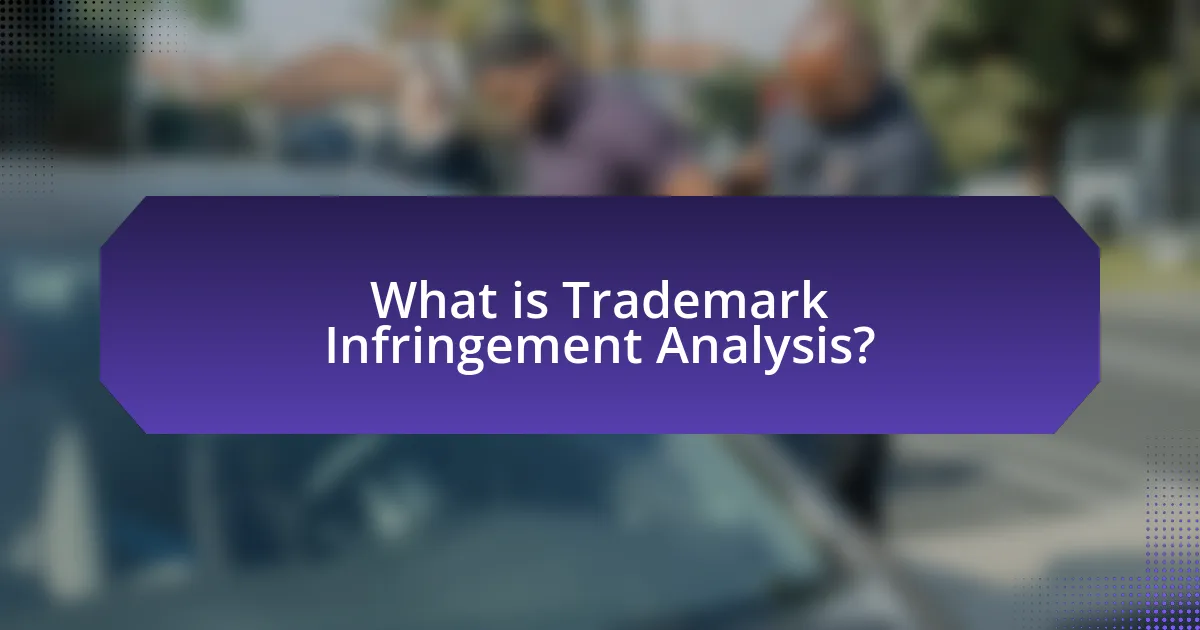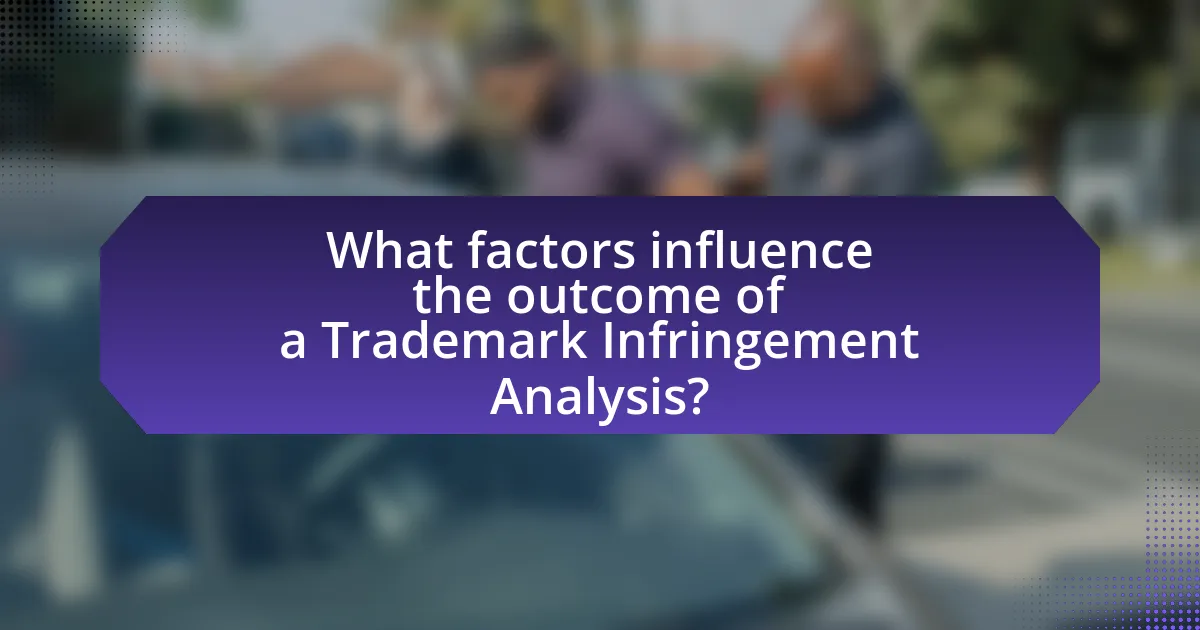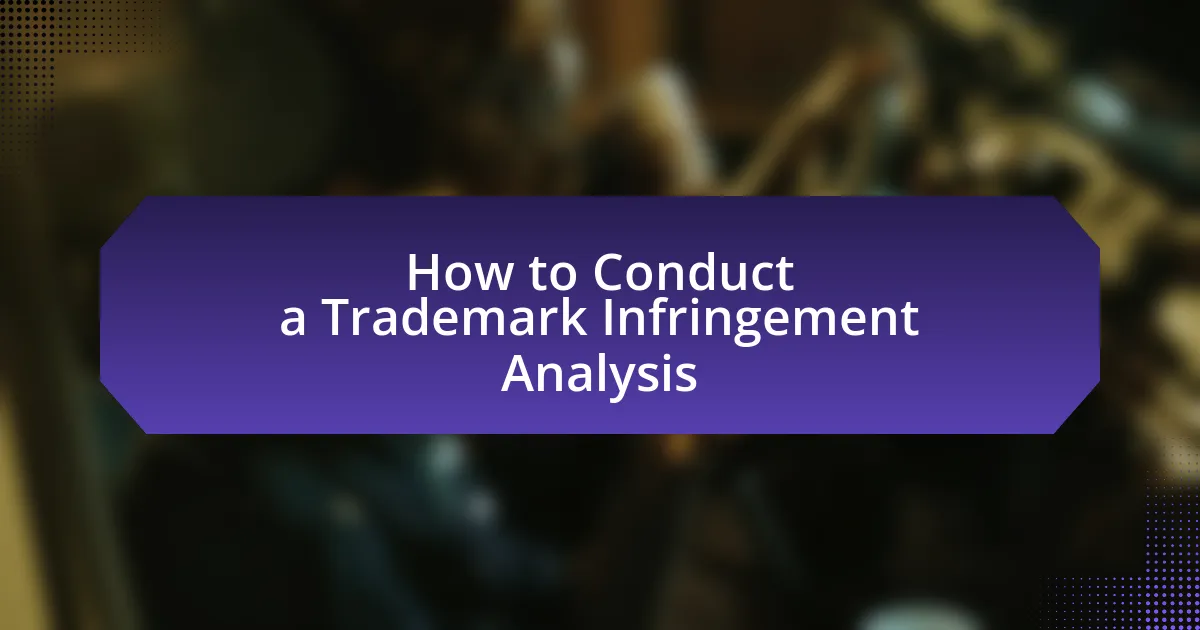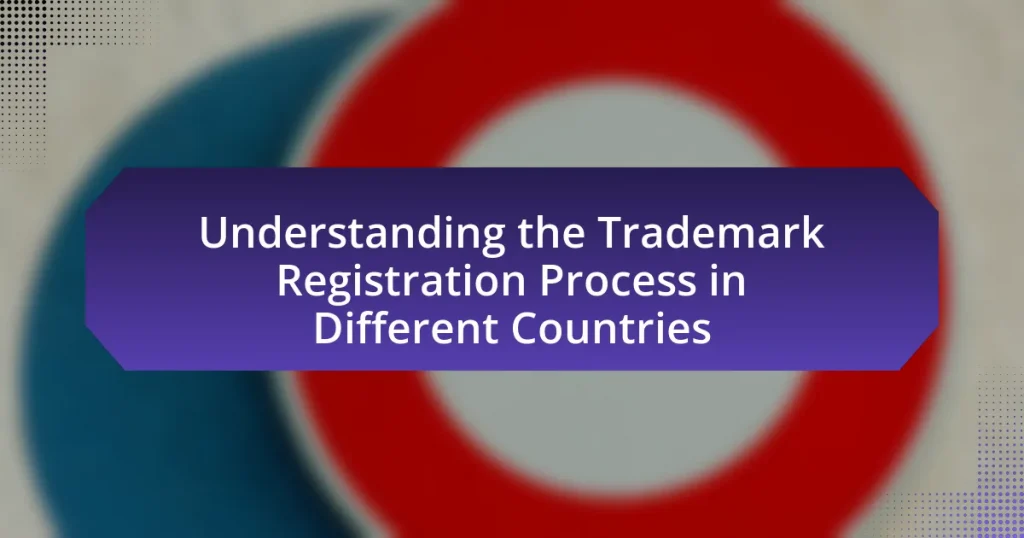Trademark Infringement Analysis is a critical process for evaluating unauthorized use of trademarks that may confuse consumers regarding the source of goods or services. This article outlines the definition of trademark infringement, the legal standards involved, and the importance of conducting a thorough analysis to protect brand identity. Key components of the analysis include identifying trademarks, assessing the likelihood of confusion, and gathering evidence to support claims. Additionally, the article discusses challenges faced during the analysis, best practices for businesses, and the role of legal counsel in navigating trademark disputes. Understanding these elements is essential for effective trademark management and enforcement.

What is Trademark Infringement Analysis?
Trademark Infringement Analysis is the process of evaluating whether a trademark is being used without authorization in a way that is likely to cause confusion among consumers. This analysis typically involves comparing the allegedly infringing mark with the registered trademark, assessing the similarity of the goods or services, and considering the channels of trade and consumer demographics. Legal precedents, such as the Lanham Act in the United States, provide a framework for determining infringement, emphasizing the importance of consumer perception and the likelihood of confusion.
How is Trademark Infringement defined?
Trademark infringement is defined as the unauthorized use of a trademark or a confusingly similar mark in a way that is likely to cause confusion among consumers regarding the source of goods or services. This legal concept protects the rights of trademark owners by preventing others from using marks that are similar enough to create a likelihood of confusion in the marketplace. Courts assess factors such as the similarity of the marks, the similarity of the goods or services, and the channels of trade to determine if infringement has occurred.
What are the legal standards for Trademark Infringement?
The legal standards for trademark infringement require proving that the defendant’s use of a mark creates a likelihood of confusion among consumers regarding the source of goods or services. Courts typically assess several factors to determine this likelihood, including the similarity of the marks, the proximity of the goods or services, the strength of the plaintiff’s mark, evidence of actual confusion, the defendant’s intent, and the marketing channels used. These factors are derived from the precedent set in the case of Polaroid Corp. v. Polarad Electronics Corp., which established a multi-factor test for evaluating trademark infringement.
Why is Trademark Infringement Analysis important?
Trademark infringement analysis is important because it helps businesses protect their brand identity and intellectual property rights. By identifying potential infringements, companies can take legal action to prevent unauthorized use of their trademarks, which can lead to consumer confusion and dilution of brand value. According to the International Trademark Association, effective trademark protection can enhance a company’s market position and foster consumer trust, making infringement analysis a critical component of brand management.
What are the key components of a Trademark Infringement Analysis?
The key components of a Trademark Infringement Analysis include the identification of the trademarks involved, the likelihood of confusion between the marks, and the examination of the goods or services associated with the marks. Identifying the trademarks involves determining the specific marks that are allegedly infringed and the marks of the accused infringer. The likelihood of confusion is assessed based on factors such as the similarity of the marks, the similarity of the goods or services, and the channels of trade. Additionally, examining the goods or services entails analyzing whether they are related or marketed to the same consumers. These components are essential for establishing whether infringement has occurred, as supported by legal precedents that emphasize the importance of confusion in trademark law.
What evidence is needed to support a Trademark Infringement claim?
To support a Trademark Infringement claim, the plaintiff must provide evidence demonstrating ownership of a valid trademark and that the defendant’s use of a similar mark is likely to cause confusion among consumers. Ownership can be established through registration with the United States Patent and Trademark Office or by demonstrating common law rights through use in commerce. Evidence of likelihood of confusion may include consumer surveys, expert testimony, and instances of actual confusion, as well as the similarity of the marks, the relatedness of the goods or services, and the channels of trade. These elements collectively substantiate the claim of infringement by showing that the defendant’s actions could mislead consumers regarding the source of the goods or services.
How do you identify the trademarks involved?
To identify the trademarks involved, conduct a thorough search of registered trademarks using databases such as the United States Patent and Trademark Office (USPTO) or the World Intellectual Property Organization (WIPO). This process includes examining the trademark’s name, logo, and any associated goods or services to determine their distinctiveness and registration status. Additionally, reviewing relevant case law and trademark registrations can provide insights into potential conflicts or similarities with existing trademarks, ensuring a comprehensive analysis of the trademarks in question.
What steps are involved in conducting a Trademark Infringement Analysis?
The steps involved in conducting a Trademark Infringement Analysis include identifying the trademark in question, assessing the likelihood of confusion, analyzing the goods or services involved, and evaluating the strength of the trademark. First, the trademark must be clearly defined to establish its scope and protection. Next, the likelihood of confusion is assessed by comparing the marks and the relatedness of the goods or services, as established in the landmark case of Polaroid Corp. v. Polarad Electronics Corp., which outlines factors to consider. Then, the analysis of goods or services involves determining whether they are similar or complementary, which can influence consumer perception. Finally, the strength of the trademark is evaluated based on its distinctiveness and recognition in the marketplace, as stronger marks receive broader protection. Each of these steps is crucial for a comprehensive analysis of potential trademark infringement.
How do you gather relevant information for the analysis?
To gather relevant information for trademark infringement analysis, one must conduct comprehensive research using multiple sources. This includes reviewing trademark databases such as the United States Patent and Trademark Office (USPTO) for registered trademarks, analyzing industry-specific publications for market trends, and examining legal databases for case law related to trademark disputes. Additionally, surveys and consumer feedback can provide insights into brand recognition and potential confusion among consumers, which are critical factors in infringement cases. These methods ensure a well-rounded understanding of the trademark landscape and support the analysis with concrete data.
What methods are used to compare trademarks?
Methods used to compare trademarks include visual comparison, phonetic comparison, and conceptual comparison. Visual comparison assesses the appearance of the trademarks, focusing on elements like logos, colors, and fonts. Phonetic comparison evaluates how similar the trademarks sound when pronounced, which is crucial for trademarks that may be verbally communicated. Conceptual comparison examines the meanings or associations of the trademarks, determining if they convey similar ideas or concepts. These methods are essential in trademark infringement analysis to establish the likelihood of confusion among consumers, which is a key factor in legal disputes.

What factors influence the outcome of a Trademark Infringement Analysis?
The outcome of a Trademark Infringement Analysis is influenced by several key factors, including the strength of the trademark, the similarity between the marks, the proximity of the goods or services, and evidence of actual confusion. The strength of the trademark refers to its distinctiveness and recognition in the marketplace; stronger trademarks are afforded greater protection. The similarity between the marks involves both visual and phonetic comparisons, where greater similarity can lead to a higher likelihood of confusion. Proximity of the goods or services assesses whether the products are related or marketed to the same consumer base, which can increase the risk of infringement. Lastly, evidence of actual confusion, such as consumer testimonies or market surveys, can significantly impact the analysis, as it demonstrates real-world implications of the trademark use. These factors collectively guide legal determinations in trademark disputes, as established in cases like Polaroid Corp. v. Polarad Electronics Corp., which outlines the importance of these elements in assessing trademark infringement.
How does the likelihood of confusion affect the analysis?
The likelihood of confusion significantly impacts the analysis of trademark infringement by determining whether consumers are likely to mistakenly associate one mark with another. This assessment is crucial because it influences the outcome of legal disputes regarding trademark rights. Courts typically evaluate several factors, including the similarity of the marks, the relatedness of the goods or services, and the channels of trade. For instance, in the case of Polaroid Corp. v. Polarad Electronics Corp., the Second Circuit established a multi-factor test to assess likelihood of confusion, which has been widely adopted in trademark law. This framework helps to clarify whether the use of a similar mark could lead to consumer confusion, thereby guiding legal decisions and potential remedies.
What are the key elements of likelihood of confusion?
The key elements of likelihood of confusion in trademark infringement analysis include the similarity of the marks, the similarity of the goods or services, the channels of trade, the sophistication of the consumers, and evidence of actual confusion. The similarity of the marks assesses how closely the trademarks resemble each other in appearance, sound, or meaning. The similarity of goods or services evaluates whether the products or services offered under the marks are related or compete in the marketplace. The channels of trade consider the marketing and distribution methods used for the goods or services, which can influence consumer perception. The sophistication of consumers examines the level of care and attention that consumers exercise when purchasing the goods or services, as more sophisticated consumers may be less likely to confuse similar marks. Finally, evidence of actual confusion, such as instances where consumers mistakenly believed one product was another, serves as strong proof of likelihood of confusion. These elements are critical in determining whether a trademark infringement has occurred.
How do consumer perceptions play a role in the analysis?
Consumer perceptions significantly influence trademark infringement analysis by shaping how consumers identify and differentiate brands. When assessing potential infringement, analysts consider whether consumers are likely to confuse two trademarks based on their perceptions, which can be informed by factors such as brand reputation, marketing strategies, and product similarities. Research indicates that 70% of consumers rely on brand names to make purchasing decisions, highlighting the importance of consumer perception in determining the likelihood of confusion in trademark cases. This understanding helps legal professionals evaluate the strength of a trademark and the potential for consumer confusion, ultimately guiding the analysis of infringement claims.
What role does the strength of the trademark play?
The strength of a trademark plays a crucial role in determining the scope of protection it receives under trademark law. Strong trademarks, which are distinctive and unique, are afforded broader protection against infringement, making it easier for the owner to enforce their rights. For instance, a trademark that is arbitrary or fanciful, such as “Apple” for computers, is considered strong and can prevent others from using similar marks in related markets. Conversely, weak trademarks, like descriptive terms, receive limited protection, as they may not be inherently distinctive and could be used by multiple entities. This distinction is supported by the Lanham Act, which emphasizes the importance of distinctiveness in trademark registration and enforcement.
How is trademark strength determined?
Trademark strength is determined by its distinctiveness, which is categorized into four levels: generic, descriptive, suggestive, and arbitrary or fanciful. Generic marks receive no protection, while arbitrary or fanciful marks are afforded the highest level of protection due to their unique nature. The distinctiveness is assessed based on factors such as the mark’s recognition by consumers, its inherent qualities, and the context in which it is used. For example, a mark that is widely recognized and associated with a specific source is considered strong, while a mark that merely describes the goods or services is deemed weak. This classification is supported by legal precedents, such as the spectrum of distinctiveness established in the case of Abercrombie & Fitch Co. v. Hunting World, Inc., which illustrates how courts evaluate trademark strength based on these criteria.
What types of trademarks are considered strong or weak?
Strong trademarks are typically arbitrary, fanciful, or suggestive, while weak trademarks are descriptive or generic. Arbitrary trademarks, like “Apple” for computers, have no inherent connection to the product, making them strong. Fanciful trademarks, such as “Kodak,” are invented words with no prior meaning, also considered strong. Suggestive trademarks, like “Coppertone” for sunscreen, imply a quality but require some imagination to connect to the product, thus being strong as well. In contrast, descriptive trademarks directly describe a product’s features, like “Creamy” for yogurt, and are considered weak unless they acquire secondary meaning. Generic trademarks, such as “Bicycle” for bicycles, are the weakest as they refer to the general category of goods and cannot be trademarked.

What are common challenges in Trademark Infringement Analysis?
Common challenges in Trademark Infringement Analysis include determining the likelihood of confusion, assessing the similarity of marks, and evaluating the strength of the trademark. The likelihood of confusion is often subjective and can vary based on jurisdiction, making it difficult to predict outcomes. Assessing similarity involves analyzing visual, phonetic, and conceptual aspects of the marks, which can be complex and nuanced. Additionally, the strength of a trademark, which is influenced by factors such as distinctiveness and market recognition, can complicate infringement claims. These challenges are supported by legal precedents and case law that highlight the intricacies involved in trademark disputes.
What difficulties arise in proving infringement?
Proving infringement presents several difficulties, primarily due to the need to establish a likelihood of confusion among consumers. This requirement necessitates a detailed analysis of various factors, including the similarity of the marks, the relatedness of the goods or services, and the channels of trade. Additionally, the burden of proof lies with the plaintiff, who must provide sufficient evidence to demonstrate that the defendant’s use of a mark is likely to cause confusion. Courts often rely on the “Polaroid factors,” which include the strength of the mark, the proximity of the goods, and evidence of actual confusion, making the process complex and subjective. Furthermore, the evolving nature of consumer perceptions and market conditions can complicate the assessment of confusion, as these factors may change over time.
How can ambiguity in trademark usage complicate the analysis?
Ambiguity in trademark usage complicates the analysis by creating uncertainty regarding the source of goods or services associated with the trademark. This uncertainty can lead to difficulties in determining whether consumer confusion exists, which is a critical factor in trademark infringement cases. For instance, if a trademark is used in multiple contexts or by different entities without clear differentiation, it becomes challenging to assess whether the usage is likely to cause confusion among consumers. Legal precedents, such as the Polaroid factors used in the Second Circuit, highlight that ambiguity can affect the evaluation of similarity, intent, and the likelihood of confusion, ultimately complicating the legal analysis and outcomes in trademark disputes.
What are the challenges in gathering evidence?
The challenges in gathering evidence for trademark infringement analysis include the difficulty in obtaining relevant documentation, the need for expert testimony, and the potential for evidence to be destroyed or altered. Relevant documentation may be hard to access due to proprietary restrictions or lack of cooperation from involved parties. Expert testimony is often necessary to interpret complex technical details, which can be costly and time-consuming to secure. Additionally, the risk of evidence being destroyed or altered, either intentionally or unintentionally, complicates the collection process, as seen in cases where businesses may not maintain proper records or may engage in practices to obscure infringing activities.
How can businesses protect themselves during the analysis?
Businesses can protect themselves during the analysis by implementing robust data security measures and ensuring compliance with legal standards. By utilizing encryption for sensitive data and restricting access to authorized personnel, businesses can safeguard their information from unauthorized access. Additionally, conducting regular audits and training employees on data protection protocols can further mitigate risks. According to the Ponemon Institute’s 2021 Cost of a Data Breach Report, organizations that have a formal incident response plan can reduce the cost of a data breach by an average of $2 million, highlighting the importance of proactive measures in protecting business interests during analysis.
What best practices should be followed in Trademark Infringement Analysis?
Best practices in Trademark Infringement Analysis include conducting a comprehensive search of existing trademarks, analyzing the likelihood of confusion between marks, and documenting all findings meticulously. A thorough trademark search helps identify potential conflicts and assess the risk of infringement, while evaluating factors such as similarity of the marks, relatedness of goods or services, and the channels of trade is crucial for determining confusion likelihood. Additionally, maintaining detailed records of the analysis process supports legal arguments and can be essential in litigation or settlement discussions. These practices are supported by legal precedents, such as the Polaroid factors used in U.S. courts to assess trademark infringement cases.
How can legal counsel assist in the analysis process?
Legal counsel can assist in the analysis process by providing expert legal interpretation of trademark laws and regulations. They evaluate the specifics of a trademark infringement case, identifying potential legal risks and advising on compliance with intellectual property laws. Legal counsel also conducts thorough research on existing trademarks, assessing similarities and potential conflicts, which is crucial for determining the likelihood of confusion in infringement cases. Their expertise ensures that the analysis is grounded in legal standards, enhancing the accuracy and reliability of the findings.
What are the next steps after completing a Trademark Infringement Analysis?
After completing a Trademark Infringement Analysis, the next steps involve determining the appropriate legal actions to take based on the findings. This may include sending a cease-and-desist letter to the infringing party, negotiating a settlement, or filing a lawsuit if necessary. The decision should be informed by the strength of the trademark rights, the extent of the infringement, and the potential impact on the brand. Legal precedents indicate that timely action can prevent further infringement and protect brand integrity, as seen in cases where companies successfully enforced their trademarks through litigation or settlement agreements.
What actions can be taken if infringement is found?
If infringement is found, the primary action is to send a cease-and-desist letter to the infringing party, demanding that they stop using the trademark. This letter serves as a formal notification of the infringement and outlines the legal rights of the trademark owner. Additionally, the trademark owner may consider filing a lawsuit for trademark infringement to seek damages and injunctive relief. According to the Lanham Act, trademark owners have the right to protect their marks and can pursue legal action against unauthorized use that causes confusion among consumers.
How can businesses prevent future trademark issues?
Businesses can prevent future trademark issues by conducting thorough trademark searches before launching new products or services. This proactive measure helps identify existing trademarks that may conflict with the new offerings, reducing the risk of infringement. According to the United States Patent and Trademark Office, conducting a comprehensive search can reveal potential conflicts and inform businesses about the viability of their trademark applications. Additionally, businesses should regularly monitor their trademarks and the market for potential infringements, ensuring they can take timely action if necessary. Implementing these practices can significantly minimize the likelihood of trademark disputes.



